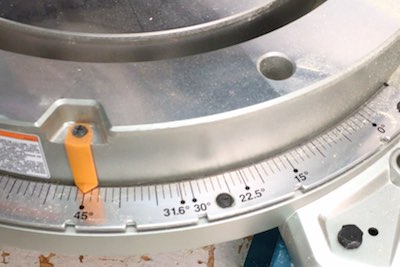I was recently at the Greater Toronto Area Home and Reno Show, teaching visitors about woodworking. One question that came up frequently from people was “What is a miter saw?” This surprised me as I’ve grown up around tools, but since there were so many questions, I thought I would share my knowledge about this tool.
What’s a Miter Saw Used For?
A miter saw is a tool designed to have the wood stationery on the miter saw table, and safely cutting across the piece of wood. The most basic cut is a cut straight across a piece of wood. This allows you to cut the wood to the desired length. The mitre saw is the most frequently used tool in my workshop.
 Another type of cut you can make on a miter saw is a miter – a cut on an angle. For example, making a 45 degree angle cut on trim to instal it around a window or door. The saw has the angles measured out (see image to the right) to show you that will be cut. Because you can set the miter saw so accurately, there isn’t a better tool for this type of work.
Another type of cut you can make on a miter saw is a miter – a cut on an angle. For example, making a 45 degree angle cut on trim to instal it around a window or door. The saw has the angles measured out (see image to the right) to show you that will be cut. Because you can set the miter saw so accurately, there isn’t a better tool for this type of work.
The third type of cut a miter saw can make is a bevel cut. This is where the blade is tilted to allow for either a straight bevel (such as a 45 degree angle for a baseboard) or a compound bevel where the saw is bevelled and the angle is set on the table as well. This is where the term “Compound Miter Saw” comes from.
Features of a Miter Saw
If you’re looking to buy a miter saw, here are some features to consider:
- Miter Angle Gauge – ensure it’s clear and ideally that it has positive stops that lock in at the frequently used angles. This makes work faster when you switch angles
- Sliding Compound Miter Saw (SCMS) – this refers to a miter saw that runs on slides and typically allows to cut 12 inches across material. A non-sliding saw (aka, a chop saw) will only cut the width of the blade when it’s pulled down to cut, which will get you through a 2×4 or a 2×6.
- Bevel Cutting – a saw that allows bevel cutting is useful, but one that allows bevel cutting on both the right and left side is more useful. Make sure you understand what the saw is capable of before you buy it
- Dust Collection – miter saws create a lot of dust! If you’re not aware yet, wood dust is a carcinogen (can cause cancer), so you should protect your lungs (see Wood Dust Health Risks). Look for a saw that has a dust collection boot behind the saw. This can help catch dust when the saw is hooked up to a shop vac. For the ultimate dust collection, see Miter Saw Dust Collection Hood
- Quality – I suggest you don’t buy the cheapest tool you can find. Buy a quality tool. I’ve owned a Makita miter saw for 20 years and I’ve only had to have it serviced once. A quality tool will give you accurate cuts and will last a very long time. I’ve had experience with cheap tools breaking, and in the end, I ended up replacing them with quality tools that will give me a long tool life.
- Corded or Cordless – if you’re looking to move your miter saw around to different locations a lot, a cordless might be a good option for you. Otherwise, slick with a corded model that won’t ever run out of battery.
I don’t have loyalty to one brand of tool, but there are a few that provide quality results at a reasonable cost. Makita, DeWalt, and Bosch make good saws. Here are a few links to compare:
- Makita LS1018 10″ Dual Slide Compound Miter Saw
- DEWALT DW717 10 in. Double-Bevel Sliding Compound Miter Saw
- Bosch 10-Inch 15-Amp Dual Bevel Axial-Glide Compact Miter Saw, CM10GD
I hope you find this information useful. The video above provides a more visual demonstration of this material. Leave us a comment if you like, or post a question.
Note: the product links provided are affiliate links, which provide our YouTube channel funding when purchases are made using the links